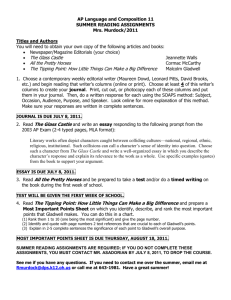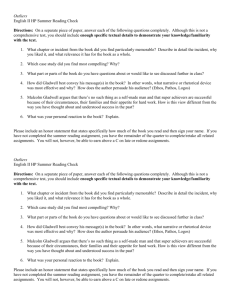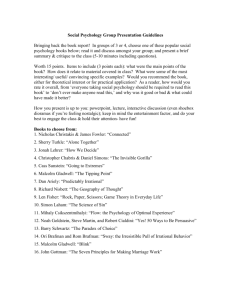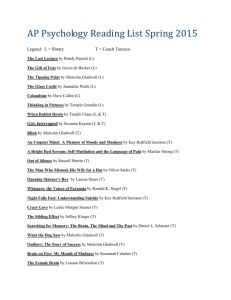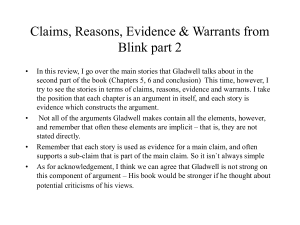Methods for Public Opinion/Social Science Research PLSC 372
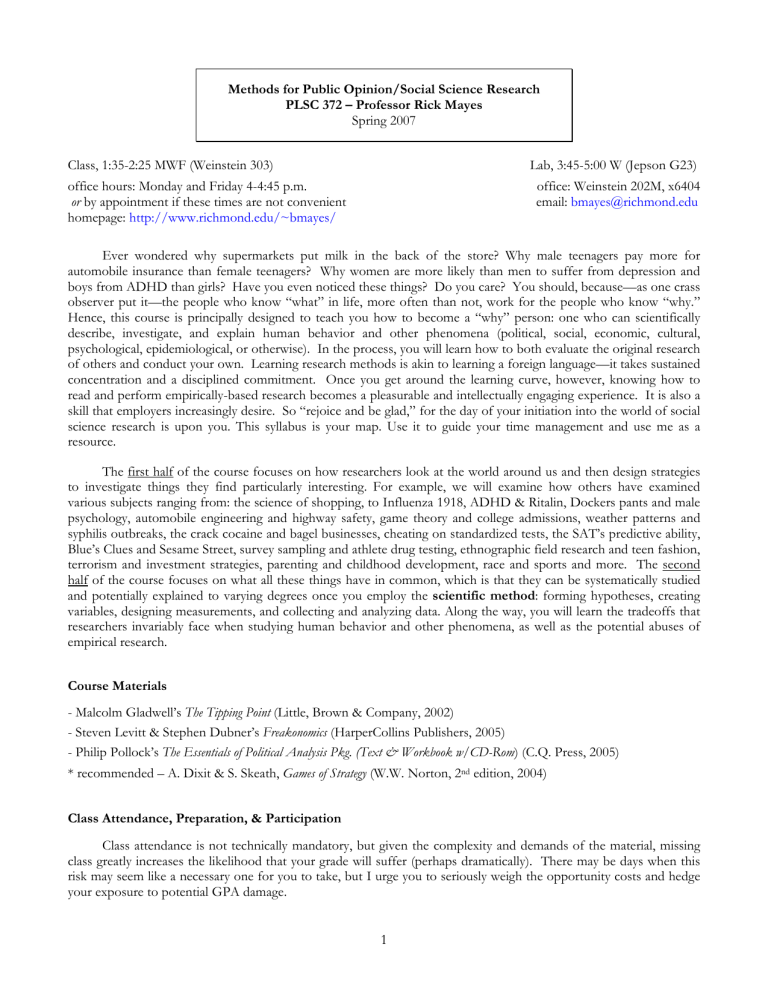
Methods for Public Opinion/Social Science Research
PLSC 372 – Professor Rick Mayes
Spring 2007
Class, 1:35-2:25 MWF (Weinstein 303) office hours: Monday and Friday 4-4:45 p.m. homepage: http://www.richmond.edu/~bmayes/
or by appointment if these times are not convenient
Lab, 3:45-5:00 W (Jepson G23)
office: Weinstein 202M, x6404
email: bmayes@richmond.edu
Ever wondered why supermarkets put milk in the back of the store? Why male teenagers pay more for automobile insurance than female teenagers? Why women are more likely than men to suffer from depression and boys from ADHD than girls? Have you even noticed these things? Do you care? You should, because—as one crass observer put it—the people who know “what” in life, more often than not, work for the people who know “why.”
Hence, this course is principally designed to teach you how to become a “why” person: one who can scientifically describe, investigate, and explain human behavior and other phenomena (political, social, economic, cultural, psychological, epidemiological, or otherwise). In the process, you will learn how to both evaluate the original research of others and conduct your own. Learning research methods is akin to learning a foreign language—it takes sustained concentration and a disciplined commitment. Once you get around the learning curve, however, knowing how to read and perform empirically-based research becomes a pleasurable and intellectually engaging experience. It is also a skill that employers increasingly desire. So “rejoice and be glad,” for the day of your initiation into the world of social science research is upon you. This syllabus is your map. Use it to guide your time management and use me as a resource.
The first half of the course focuses on how researchers look at the world around us and then design strategies to investigate things they find particularly interesting. For example, we will examine how others have examined various subjects ranging from: the science of shopping, to Influenza 1918, ADHD & Ritalin, Dockers pants and male psychology, automobile engineering and highway safety, game theory and college admissions, weather patterns and syphilis outbreaks, the crack cocaine and bagel businesses, cheating on standardized tests, the SAT’s predictive ability,
Blue’s Clues and Sesame Street, survey sampling and athlete drug testing, ethnographic field research and teen fashion, terrorism and investment strategies, parenting and childhood development, race and sports and more. The second half of the course focuses on what all these things have in common, which is that they can be systematically studied and potentially explained to varying degrees once you employ the scientific method : forming hypotheses, creating variables, designing measurements, and collecting and analyzing data. Along the way, you will learn the tradeoffs that researchers invariably face when studying human behavior and other phenomena, as well as the potential abuses of empirical research.
Course Materials
- Malcolm Gladwell’s The Tipping Point (Little, Brown & Company, 2002)
- Steven Levitt & Stephen Dubner’s Freakonomics (HarperCollins Publishers, 2005)
- Philip Pollock’s The Essentials of Political Analysis Pkg. (Text & Workbook w/CD-Rom ) (C.Q. Press, 2005)
* recommended – A. Dixit & S. Skeath, Games of Strategy (W.W. Norton, 2 nd edition, 2004)
Class Attendance, Preparation, & Participation
Class attendance is not technically mandatory, but given the complexity and demands of the material, missing class greatly increases the likelihood that your grade will suffer (perhaps dramatically). There may be days when this risk may seem like a necessary one for you to take, but I urge you to seriously weigh the opportunity costs and hedge your exposure to potential GPA damage.
1
c
Honor Code: Every assignment and exam must be submitted with your signature next to the full written pledge:
“ I pledge that I have neither received nor given unauthorized assistance during the completion of this work .”
Failure to do this will result in your work not being graded or accepted for credit.
Assignments and Grading
Participation/Discussion
Mid-Term )
Lab Reports (six total, your 1 st lab on 2/16 is for practice only *)
5%
25%
30%
2/16 1
2/23 2
3/16 3
3/23 4 st nd rd th
Lab Report: Ch. 2 “Descriptive Statistics”
Lab Report: Ch. 3 “Making Comparisons”
Lab Report: Ch. 6 “Making Inferences”
*
5%
Lab Report: Ch. 5 “Making Controlled Comparisons” 5%
5%
3/30 5 th Lab Report: Ch. 7 “Chi-Square/Measures of Association” 5%
4/6 6 th Lab Report: Ch. 8 “Correlation and Regression” 5%
4/13 7 th Lab Report: Ch. 4 “Transforming Variables” 5%
Team Research Project
Final Exam
Grades
" Abandon hope, all 'ye who have become accustomed to grade inflation ."
20%
20%
Total 100%
This class is, by virtue of the subject matter and inherent learning curve, something of a grade-deflator. Keep your grade expectations modest and you are less likely to be disappointed. Everyone begins the class with zero (0) points. Through exams, class participation, lab reports, and the survey research project you earn points over the course of the semester. The number of points you earn determines the grade you receive. D/F is representative of work that is poor/incomplete; C, adequate; B, excellent; and A, perfect or near-perfect (and rare).
Scoring: A= 100-96 A-= 95-91 B+= 90-88
B= 87-83 B-= 82-81 C+= 80-78
C= 77-73
D= 67-63
C-= 72-71
D-= 62-61
D+= 70-68
F= 60-0
Please be aware that under no circumstances will extra credit be available. Consequently, it is imperative that you do your best on each and every assignment. I am available outside of class to help you, so please consider me a resource. That’s fundamentally why I am here as your professor – to help you.
Late Policy
My policy is firm but fair. I don’t expect to use this policy, but if it has to go into effect it will. In brief, paper and lab projects will be automatically reduced one full grade for every day late. Any paper submitted more than 2 days late will receive an automatic “F.” Those with genuine emergencies will be given extensions, but they must be cleared with me in advance .
2
ASSIGNMENTS
Monday, January 15
I. INTRODUCTION TO THINKING EMPIRICALLY and EXPLAINING HUMAN & ORGANIZATIONAL BEHAVIOR
Overview of the course
Epidemics, Hush Puppies & Retail Anthropology
- Gladwell, The Tipping Point , Introduction (pp. 3-14)
Shopping,” http://www.richmond.edu/~bmayes/pdf/Gladwell_Science_of_Shopping.pdf
Wednesday, January 17 Probability Primer, Khakis & the Tricky “Science” of Male Fashion
- Gladwell, The Tipping Point , Chapter 1 (pp. 15-29)
- M. Gladwell, “Listening to Khakis: What America’s most popular pants
tell us about the way guys think,” The New Yorker http://www.richmond.edu/~bmayes/pdf/Gladwell_Khakis.pdf
Lab Session for Week 1 (1/17)
Friday, January 19
-
- Gladwell, The Tipping Point , Chapter 2 (pp. 30-53)
Ritalin (April 1999) http://www.richmond.edu/~bmayes/pdf/Eberstadt_WhyRitalinRules.pdf
- PBS Frontline’s “Medicating Kids” [watch this entire documentary online] http://www.pbs.org/wgbh/pages/frontline/shows/medicating/adhd/
Monday, January 22
Ethnography Studies, Focus Groups & Corporate/Market Research
- PBS Frontline’s, “The Merchants of Cool” http://www.pbs.org/wgbh/pages/frontline/shows/cool/view/ (watch)
The Law of the Few, Biological Determinism & ADHD
Acquaintance Networks, Predictive Validity I & Profiling/Risk Assessment
- Gladwell, The Tipping Point , Chapter 2 (pp. 53-74)
- L. Menand, “Everybody’s an Expert: Putting Predictions to the Test,” The New Yorker (2005) http://www.newyorker.com/printables/critics/051205crbo_books1
- M. Gladwell, “Troublemakers: What Pit Bulls Can Teach Us about Profiling,” New Yorker http://www.richmond.edu/~bmayes/pdf/Gladwell_pitbulls_profiling.pdf
Wednesday, January 24
- http://www.gladwell.com/pdf/babysteps.pdf
Parents The New Yorker (August 1998) http://www.richmond.edu/~bmayes/pdf/Gladwell_Parenting.pdf
Lab Session for Week 2 (1/24)
Utility, Persuasion & Scientists in the Crib
- Gladwell, The Tipping Point , Chapter 2 (pp. 74-88)
- M. Gladwell, “Baby Steps: Do our first three years of life determine how we will turn out?”
- R. Walker, “The Hidden (in Plain Sight) Persuaders,” New York Times Magazine (2005) http://www.richmond.edu/~bmayes/pdf/RWalker_Persuaders.pdf
Ethnography Studies II, Focus Groups II & Corporate/Market Research II
- PBS Frontline’s “The Persuaders,” read the following introduction: http://www.pbs.org/wgbh/pages/frontline/shows/persuaders/etc/synopsis.html
Friday, January 26 Happiness, Psychological Immune Systems & Sesame Street
- Gladwell, The Tipping Point , Chapter 3 (pp. 89-110)
- J. Gertner, “The Futile Pursuit of Happiness,” New York Times (September 2003) http://www.richmond.edu/~bmayes/pdf/Futile%20Pursuit%20of%20Happiness.pdf
- C. Caldwell, “Can You Have Too Many Choices?” The New Yorker (March 2004) http://www.newyorker.com/printable/?critics/040301crbo_books
3
Monday, January 29 Blues Clues and the Facial Action Coding System (FACS)
- Gladwell, The Tipping Point , Chapter 3 (pp. 110-132)
- M. Gladwell, “The Naked Face: Can you read people’s thoughts just by
looking at them?” The New Yorker (August 2002) http://www.gladwell.com/pdf/nakedface.pdf
Wednesday, January 31
Lab Session for Week 3 (1/31)
Personality Tests, Predictive Validity II & Failure
- M. Gladwell, “Personality Plus,” The New Yorker (September 2004) http://www.gladwell.com/pdf/personality.pdf
- M. Gladwell, “The Art of Failure: Why Some People Choke and Others Panic” (2000) http://www.gladwell.com/pdf/choking.pdf
- M. Gladwell, “Connecting the Dots: The Paradoxes of Intelligence Reform” (2003) http://www.gladwell.com/pdf/dots.pdf
Behavioral Prediction, Standardized Tests & Case Studies
- M. Gladwell, “Examined Life: What Stanley H. Kaplan taught us about the
S.A.T.,” The New Yorker (December 2001) http://www.gladwell.com/pdf/kaplan.pdf
- T. Egan, “Little Asia on the Hill: U.C. Berkeley,” New York Times (January 2007) http://www.richmond.edu/~bmayes/pdf/Little_Asia_onthe_Hill_NYT.pdf
II. RESEARCH DESIGN and THE MEASUREMENT & OPERATIONALIZATION OF VARIABLES
Friday, February 2 The Power of Context, Crime Reduction & How to Define a Concept
- Gladwell, The Tipping Point , Chapter 4 (pp. 133-169)
- Pollock, The Essentials of Political Analysis , Chapter 1 (pp. 1-12)
Monday, February 5 Game Theory, College Admissions & the Early-Decision Dilemma
- Organization (April 2001)
- http://www.richmond.edu/~bmayes/pdf/The_Organization_Kid.pdf
Early-Decision The Atlantic Monthly (September 2001) http://www.richmond.edu/~bmayes/pdf/The_Early_Decision_Racket.pdf
Wednesday, February 7 Operational Definitions, the Rule of 150 & Why We Worry Wrongly
- Gladwell, The Tipping Point , Chapter 5 (pp. 169-181)
- Pollock, The Essentials of Political Analysis , Chapter 1 (pp. 13-20)
- J. Kluger, “Why We Worry Wrongly,” TIME (November 2006) http://www.richmond.edu/~bmayes/pdf/TIME_Worrying_Wrongly.pdf
Lab Session for Week 4 (2/7) Predictive Validity III and Case Studies II
- L. Belkin, “The Opt-Out Revolution,” New York Times Magazine (October 2003) http://www.richmond.edu/~bmayes/pdf/The%20Opt-Out%20Revolution.pdf
Friday, February 9 Variables, Transactive Memory & the Challenges of Survey Research
- Gladwell, The Tipping Point , Chapter 5 (pp. 182-192)
- B. Carey, “Long After Kinsey, Only the Brave Study Sex,” New York Times http://www.richmond.edu/~bmayes/pdf/Long%20After%20Kinsey_Nov2004.pdf
- NPR’s Talk of the Nation, “Kinsey Report, 50 Years Later” [listen to this program] http://www.npr.org/templates/story/story.php?storyId=4161159
- Pollock, The Essentials of Political Analysis , Chapter 1 (pp. 20-25)
Monday, February 12 Average/Mean vs. Outlier/Tail Differences & from Variable to Explanation
- Gladwell, The Tipping Point , Chapter 6 (pp. 193-215)
- M. Gladwell, “The Sports Taboo: Why blacks are like boys and whites are like girls,” http://www.richmond.edu/~bmayes/pdf/Gladwell_Drug%20Testing.pdf
- Pollock, The Essentials of Political Analysis , Chapter 2 (pp. 28-33)
4
Wednesday, February 14 Predictive Validity IV, Teen Smoking & from Explanation to Hypothesis to Test
- Gladwell, The Tipping Point , Chapter 6 (pp. 216-252)
- M. Gladwell, “Blowing Up: How Nassim Taleb turned the inevitability of
disaster into an investment strategy,” The New Yorker (April 2002) http://www.gladwell.com/pdf/blowingup.pdf
- Pollock, The Essentials of Political Analysis , Chapter 2 (pp. 34-47)
III. DATA ANALYSIS
Lab Session for Week 5 (2/14)
Friday, February 16
Monday, February 19
Wednesday, February 21
Lab Session for Week 6 (2/21)
Friday, February 23
Monday, February 26
Wednesday, February 28
Lab Session for Week 7 (2/28)
Friday, March 2
SPRING BREAK
Monday, March 12
Wednesday, March 14
Introduction to SPSS, Univariate Analysis & Descriptive Statistics
- Pollock, An SPSS Companion… , Introduction, Getting Started et al. (pp. 1-23)
Due ** 1 st LAB REPORT: An SPSS Companion , Ch. 2, Exercises 1-5 (pp. 23-29) **
- (meetings with me to discuss your survey research projects)
Variables II, Comparisons & the Epidemiology of Traffic Safety
- M. Gladwell, “Wrong Turn: How the fight to make America’s highways
safer went offcourse,” The New Yorker (June 2001) http://www.gladwell.com/pdf/wrongturn.pdf
- M. Gladwell, “Big and Bad: How the SUV Ran Over Automotive Safety” New Yorker (2005) http://www.gladwell.com/pdf/suv.pdf
- Pollock, The Essentials of Political Analysis , Chapter 3 (pp. 51-74)
Making Comparisons, the Pill & Risk Factors for Teen Suicide
- M. Gladwell, “John Rock’s Error: What the co-inventor of the Pill didn’t know:
menstruation can endanger women’s health,” New York Times (March 2000) http://www.gladwell.com/pdf/johnrock.pdf
Dilemma,” (November 2004) http://www.richmond.edu/~bmayes/pdf/The%20Antidepressant%20Dilemma_NYT.pdf
Bivariate Analysis I
- Pollock, An SPSS Companion… , Ch. 3 “Making Comparisons” (pp. 31-46)
Due ** 2 nd LAB REPORT: An SPSS Companion , Ch. 3, Exercises 1-9 (pp. 46-57) **
- (meetings with me to discuss your survey research projects) study day
** MID-TERM EXAM (Part I) **
** MID-TERM EXAM (Part II) ** work on the design of your research project
Making Controlled Comparisons, Pima Indians & Class 3 Obesity
- Pollock, The Essentials of Political Analysis , Chapter 4 (pp. 77-100)
- M. Gladwell, “The Pima Paradox: Can we learn how to lose weight from
one of the most obese people in the world?” The New Yorker (February 1998) http://www.richmond.edu/~bmayes/pdf/Pima%20Paradox_Gladwell.doc
Sampling, Drug Tests & the Misery of Being “Average”
- M. Gladwell, “Drugstore Athlete,” The New Yorker (September 2001) http://www.gladwell.com/pdf/doping.pdf
- A. Gawande, “The Bell Curve,” The New Yorker (December 2004) http://www.richmond.edu/~bmayes/pdf/Atul_Gawande_The%20Bell%20Curve.pdf
- Pollock, The Essentials of Political Analysis , Chapter 5 (pp. 102-107, 112-114)
5
Lab Session for Week 8 (3/14) Bivariate Analysis II
- Pollock, An SPSS Companion… , Ch. 5 “Controlled Comparisons” (pp. 75-95)
Friday, March 16 Due ** 3 rd LAB REPORT: An SPSS Companion , Ch. 5, Exercises 1-4 (p. 96-102) **
Monday, March 19
- (meetings with me regarding your project & time for you to do your field research)
Making Inferences, Schoolteachers & Sumo Wrestlers
- Pollock, The Essentials of Political Analysis , Chapter 5 (pp. 116-124)
- Levitt & Dubner, Freakonomics , pp. 3-51
Wednesday, March 21 Tests of Significance, the Ku Klux Klan & Real Estate Agents
- Levitt & Dubner, Freakonomics , pp. 55-85
Lab Session for Week 9 (3/21) Inference
- Pollock, An SPSS Companion… , Ch. 6 “Making Inferences” (pp. 103-115)
Friday, March 23
Monday, March 26
Due ** 4 th LAB REPORT: An SPSS Companion , Ch. 6, Exercises 1-3 (pp. 115-116) **
- (meetings with me regarding your project & time for you to do your field research)
Chi-square, Tests of Significance II, Why Drug Dealers Still Live with
their Moms & Power-Law Distributions
- Levitt & Dubner, Freakonomics , pp. 89-114
- M. Gladwell, “Million-Dollar Murray,” The New Yorker http://www.richmond.edu/~bmayes/pdf/Gladwell_MillionDollar.pdf
- Pollock, The Essentials of Political Analysis , Chapter 6 (pp. 139-144)
Wednesday, March 28 Measures of Association, Abortion & Where Have All the Criminals Gone?
- Levitt & Dubner, Freakonomics , pp. 117-144
- Pollock, The Essentials of Political Analysis , Chapter 6 (pp. 144-150)
Lab Session for Week 10 (3/28) Chi-square and Measures of Association
- An SPSS Companion… , Ch. 7 “Chi-Square/Measures of Association” (pp. 119-127)
Friday, March 30
Monday, April 2
Due ** 5 th LAB REPORT: An SPSS Companion , Ch. 7, Exercises 1-4 (pp. 127-132) **
Correlation, What Makes a Perfect Parent & a Perfect Spouse?
- Levitt & Dubner, Freakonomics , pp. 145-204
- A. Sutherland, “Modern Love: What Shamu Taught Me about a Happy Marriage,” New York Times http://www.richmond.edu/~bmayes/pdf/Shamu_ModernLove_NYT.pdf
- Pollock, The Essentials of Political Analysis , Chapter 7 (pp. 154-157)
Wednesday, April 4 Regression, Bias, Why Decisions Disappoint & the Mismeasure of Poverty
- Levitt & Dubner, Freakonomics , pp. 205-207
- B. Gilbert, “I’m O.K., You’re Biased,” New York Times (2006) http://www.richmond.edu/~bmayes/pdf/ImOK_YoureBiased_NYT.pdf
- Pollock, The Essentials of Political Analysis , Chapter 7 (pp. 157-165, 168-170)
Poverty,” (August/September 2006) http://www.richmond.edu/~bmayes/pdf/Poverty_PolicyReview_2006.pdf
Lab Session for Week 11 (4/4) Correlation and Regression
- Pollock, An SPSS Companion… , Ch. 8 “Correlation & Regression” (pp. 133-148)
6
Friday, April 6
Monday, April 9
Wednesday, April 11
Lab Session for Week 12 (4/11)
Friday, April 13
Mon., April 16 – Wed., April 25
Friday, April 27
~~~ ~~~~~~~~~~~~~~~
FINAL EXAM TBA
Due ** 6 th LAB REPORT: An SPSS Companion , Ch. 8, Exercises 1-5 (pp. 148-153) ** work on your research projects and meet with me to discuss your progress work on your research projects and meet with me to discuss your progress
Transforming Variables in SPSS
- Pollock, An SPSS Companion… , Ch. 4 “Transforming Variables in SPSS” (pp. 59-71)
Due ** 7 th LAB REPORT: An SPSS Companion , Ch. 4, Exercises 1-2 (pp. 71-74) **
** Team Research Presentations **
Conclusion and Review
- Gladwell, The Tipping Point , Afterword: “The Rise of Immunity” (pp. 253-280)
- Francis Collins: Director, National Human Genome Research Institute,
“Seek A Balanced Life,” University of Virginia Commencement Address http://www.virginia.edu/majorevents/speeches/01speech.html
7
